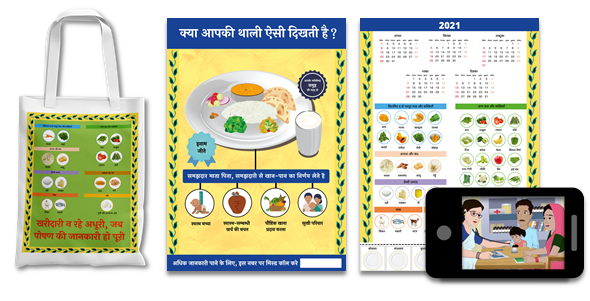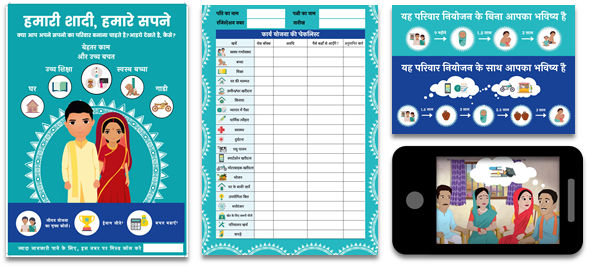Notification: PCI India has successfully migrated from pciglobal.org to pciglobal.in. All emails received from our new domain pciglobal.in are to be treated as undisputed origin.
- About Us
- Our Work
- Health and Nutrition
- Gender, DEI and Social Norms
- Women’s Economic Empowerment and Livelihoods
- Social and Environment Protection
- Emergency Response
- Skilling & Employability
- Our Expertise
- PCI Research
- Events
- Resources
- Get Involved
- About Us
- Our Work
- Health and Nutrition
- Gender, DEI and Social Norms
- Women’s Economic Empowerment and Livelihoods
- Social and Environment Protection
- Emergency Response
- Skilling & Employability
- Our Expertise
- PCI Research
- Events
- Resources
- Get Involved
Family Health Outcomes
Reflections From a Journey to Design and Test Programs in Rural Bihar
The Programs
PCI and Dalberg, with support from the Bill & Melinda Gates Foundation, set out in 2019 to answer the question: How might we engage men in nutrition and family planning through innovative and gender transformative programs in rural Bihar? We used an interdisciplinary approach anchored on human-centred design (HCD) research and behavioural science, supported by a literature review, expert interviews, rapid prototype testing and a proof-of-concept phase (with 2000 households in two blocks of Samastipur district, Bihar) to design and test innovative programmatic solutions. We closely collaborated with community representatives as partners during research, co-creation, and testing, and explored multiple program ideas, ultimately arriving at two innovative programmatic solutions:Dekh-Rekh:

Make healthy habits your family goal
Couples are provided with tools to visualise their nutrition habits and relate them to their aspirations, along with a financial planning course. This encourages them to have more conversations on food choices and make more informed and collaborative decisions on what they purchase for, prepare and feed their children.
Impact :
Minimum dietary diversity (MDD): Women in intervention villages reported a 30% point increase in MDD for children (aged 12-23 months) and men reported 25% points. These are significant compared to the 15% point increase reported by women in comparison villages and the 12% reported by men.
Mother’s dietary diversity: The percentage of mothers (of children aged 6-23 months) eating 5 or more food groups increased by a net of 14%.
Men’s involvement in nutrition: Women in the intervention villages reported a net increase of 5% points in their husbands providing enough funds to meet their children’s food requirements, compared to those in the comparison. There was a net increase of 20% points in men reporting they ‘always’ or ‘sometimes’ discussed or participated in food preparation in intervention villages, relative to comparison villages. Finally, there was a net increase of 18% points found among women in intervention villages saying their husband’s participated in feeding, relative to comparison villages.
Knowledge: Awareness among mothers about the minimum dietary diversity for children (aged 6-23 months) increased by a net of 34% among those exposed to program interventions compared to those not exposed. The net increase for men was 22% points.
Spousal communication: Couple’s communication about child nutrition increased by 24% among the exposed couples compared to those not exposed.
Hamari Shaadi, Hamare Sapne: Build savings, build a 'happy family'

Newly-wed couples enrol in a financial education course that helps them better understand how they can achieve their aspirations. This serves as a platform to incorporate conversations on family planning, delaying, spacing and limiting as a way to reach their financial goals and overall family well-being.
In both programs, couples from the community (CRPs) deliver the programs to enrolled couples. They facilitate an open environment for the couples and the family elders to talk about sensitive issues.
Impact :
Contraceptive use: There was a net increase of 16% points in current use of contraceptives among women exposed to program interventions, compared to those not exposed.
Joint goal setting: There was a net increase of 18% points in the proportion of women in intervention villages reporting that they had discussed delaying or spacing with their husbands in the preceding 3 months, and a net 25% point increase in men reporting discussing delaying or spacing in the intervention village, relative to the comparison village.
Spousal support: A significantly higher number of women (16%) from intervention villages reported increased support from their husbands on contraceptive use, and men similarly reported support for their wives’ views around family planning and contraceptive use.
Knowledge: As a result of the program, 48% of women and 82% of men knew about family planning at endline in the intervention villages, a net increase of 33% points for women and 31% points for men.
Implications of the Findings
Findings from the learning pilot show the immense potential of these programs to change couples’ family planning and nutrition behaviours and provide early indications of influence on gender and health outcomes. We see these programs as ready to enter large-scale testing, to strengthen our evidence on sustained behaviour change and outcomes. This can be done by saturating the state of Bihar; deploying the programs across multiple Indian states; or at-scale testing to make further program refinements and adjustments. In addition, lessons on using an integrated HCD and behavioural science approach to program design, with a strong gender lens; as well as an approach to health programming that builds both individual and couple’s agency and joint decision-making, can be applied to other fields, both within and outside the domain of health.
For more information visit www.engagemen.in
